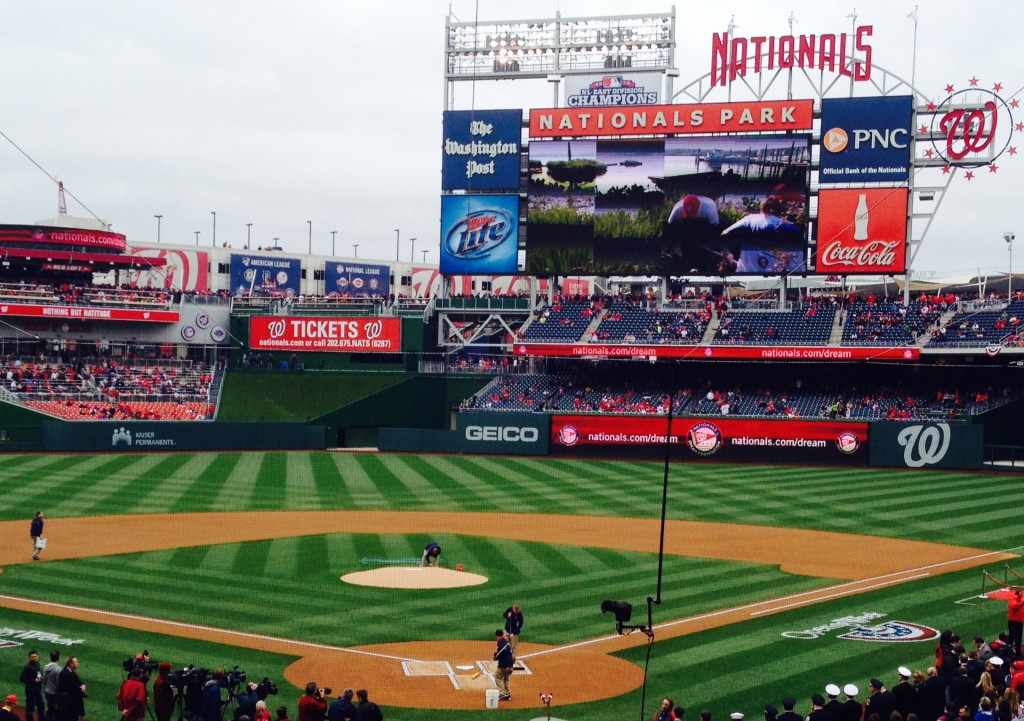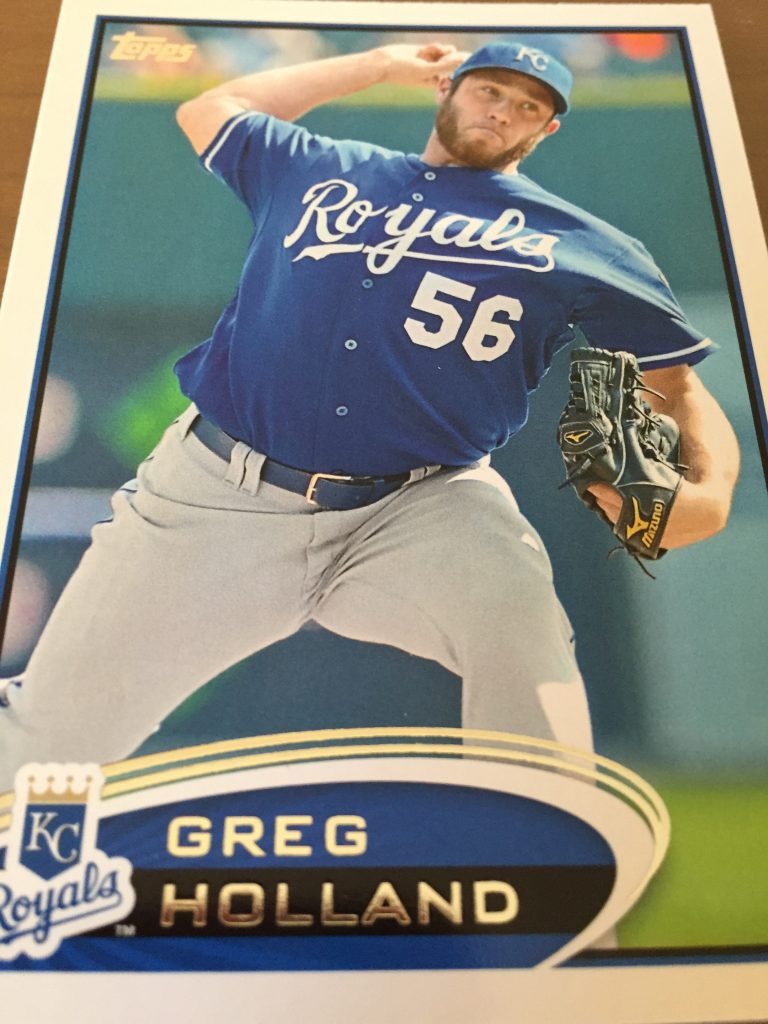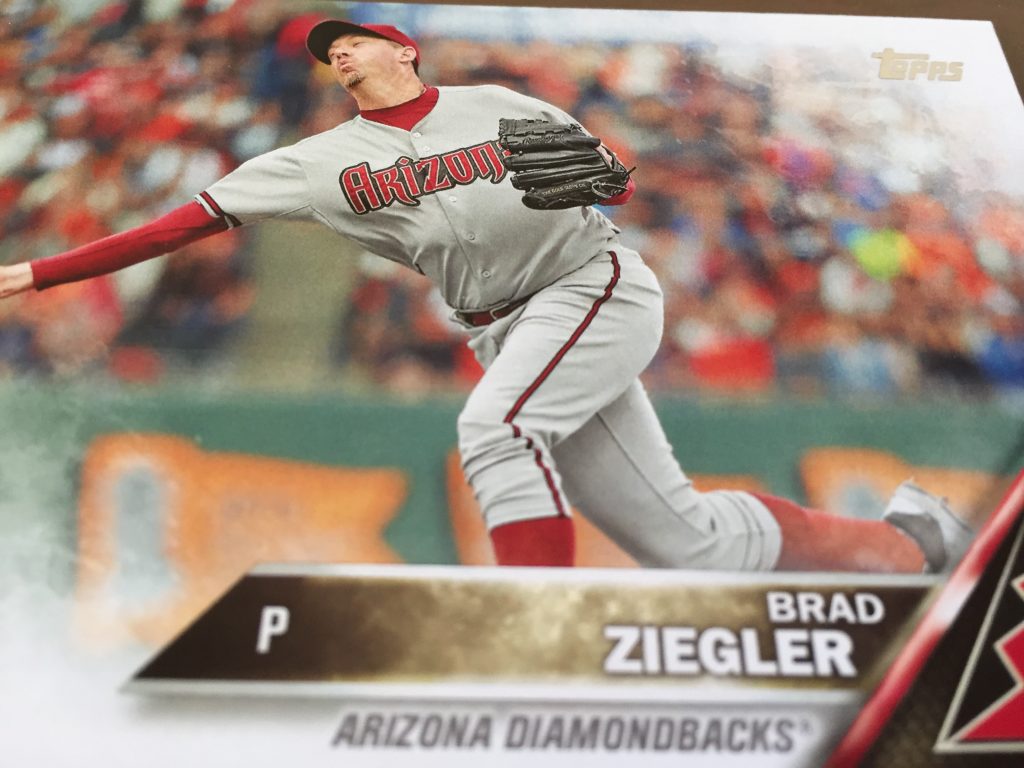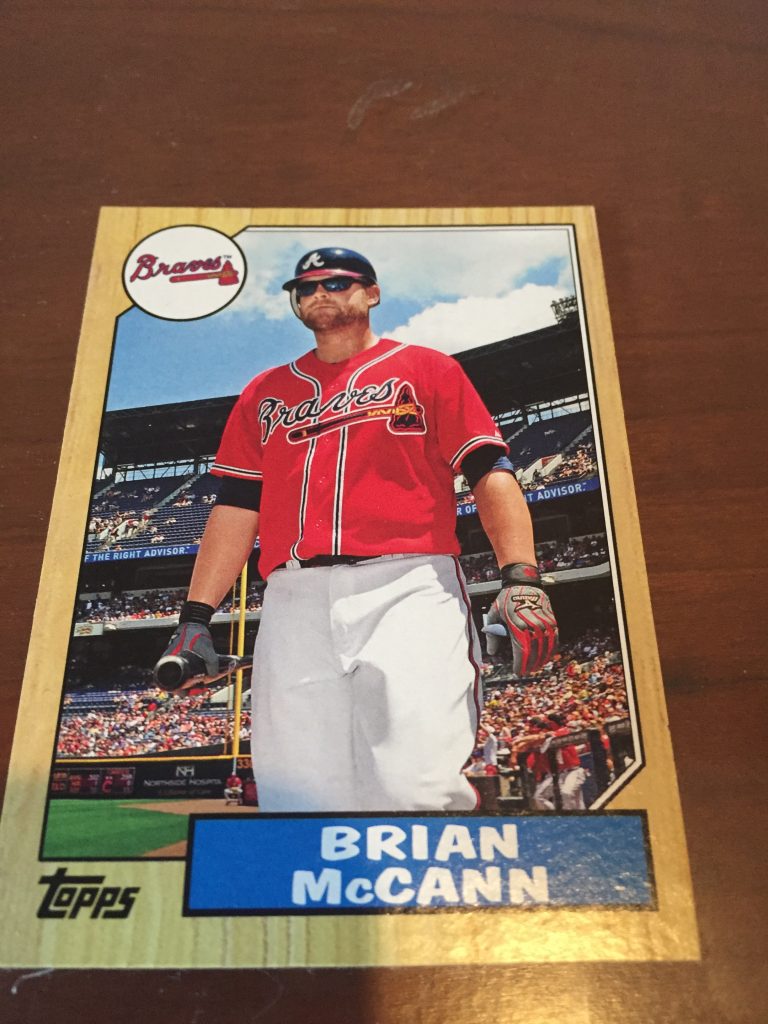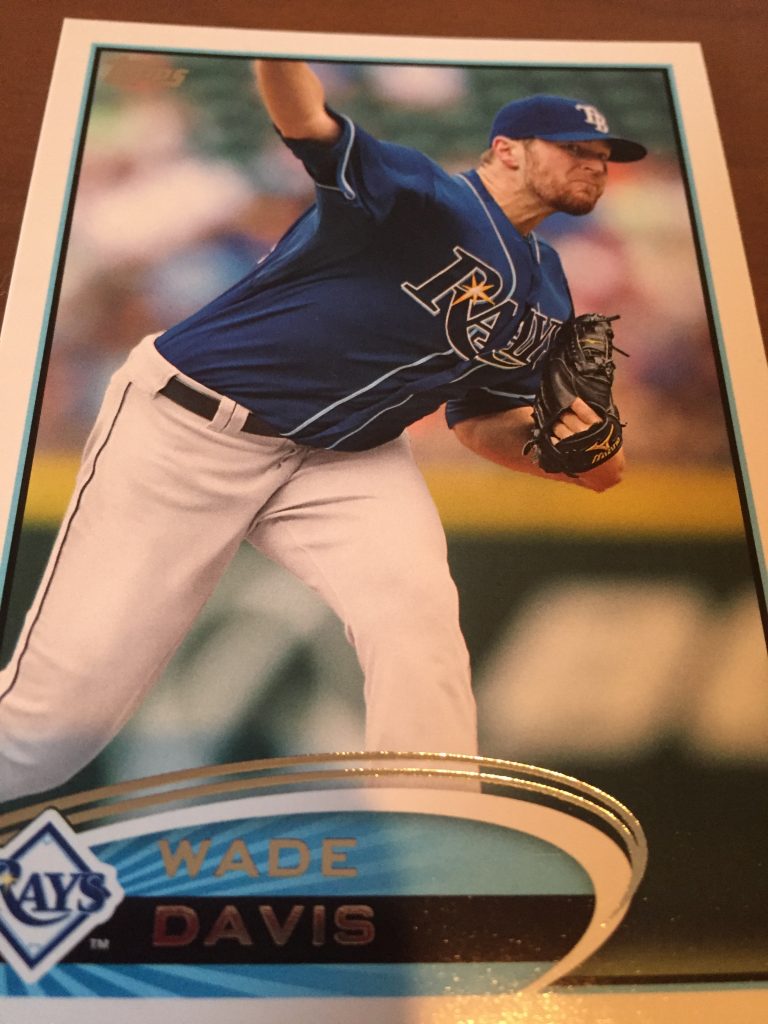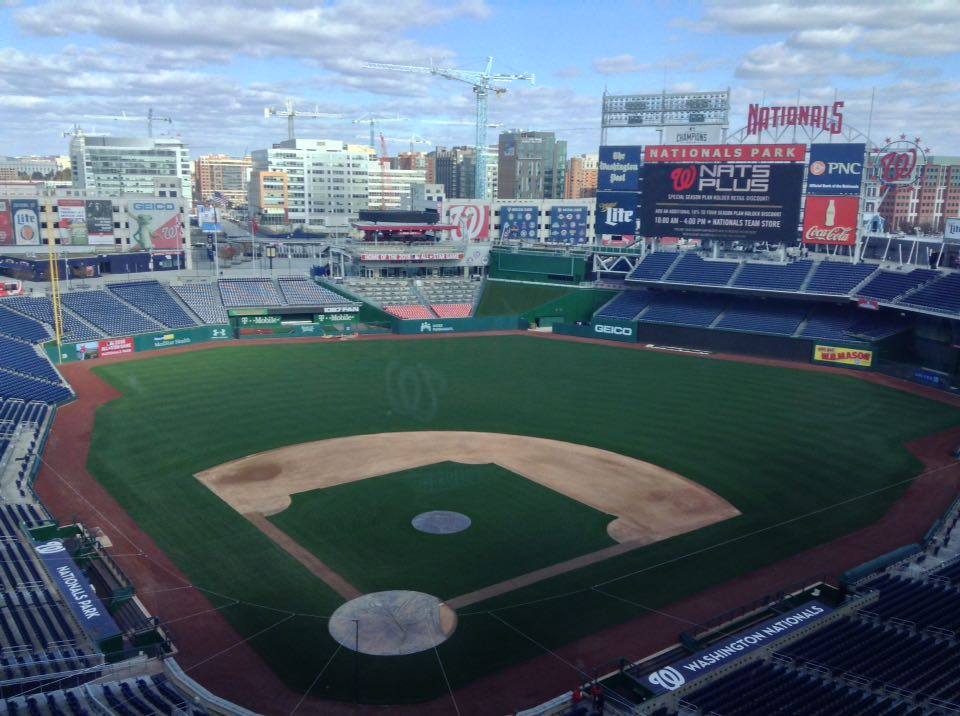The 2016 Washington Nationals enjoyed a tremendous year, winning 95 games and capturing the National League East division for the 3rd time in 5 seasons. No question the loss in Game 5 of the National League Division Series leaves a sour taste for both the fans and organization, but most should consider last season a success.
Now General Manager Mike Rizzo and Washington’s front office must look toward 2017 and how they can improve their roster to advance in the playoffs and win a World Series. The roster seems fairly spoken for, with potentially 20 of the 25 roster spots already locked up, although the team has clear needs at catcher, closer and improved roster depth. Also, there are questions about payroll, as the ambiguity involving the team’s television revenue likely puts a ceiling on what the team can spend this winter.
Last season Washington’s pitching staff was outstanding, finishing 2nd in Major League Baseball in team ERA (3.51), 2nd in total strikeouts (1,476), 11th in total walks allowed (468), and 3rd in batting average against (.234). These numbers compare favorably against the 2015 pitching staff, who finished with an ERA of 3.62, 1,342 strikeouts, 364 walks allowed and a batting average against of .250.
In Part-1, I have tried to rebuild the back of Washington’s bullpen through trades in order to be budget conscious, while also building a deep relief corps with pitchers of varying styles. The starting rotation will miss Gio Gonzalez’s dependability, but considering the overall payroll and his status as the 5th starter, his departure and the reallocation of his salary was necessary. However, I did not want to rely too heavily on youngsters Joe Ross and a the combination of A.J. Cole, Lucas Giolito and Reynaldo Lopez to manage the back-end of the rotation, so I signed a competent, veteran innings-eater to shore up the pitching staff.
Finally, to make this realistic, I am assuming Washington will have a $160 million payroll next season, up from $145 million last season but in line with the $162 million in 2015. Therefore, I prioritized keeping the salary total for the 12 members of the pitching staff below $75 million, no small feat considering Scherzer and Strasburg make a combined $40 million themselves. Keeping these factors in mind, here is my master plan to build a pitching staff capable of winning the 2017 World Series.
2017 Washington Nationals Hypothetical Payroll -> $160 million
Signings -> Jon Niese 1yr $4 million plus incentives
Trades -> 1) Washington trades LHP Gio Gonzalez to Miami for *** and A Top Prospect
2) Washington trades RHP Blake Treinen and OF Andrew Stevenson to St. Louis for RHP Trevor Rosenthal
3) Washington trades SS Danny Espinosa to Seattle for RHP Steve Cishek
Starting Rotation
SP #1 – Max Scherzer $22,143,000
SP #2 – Stephen Strasburg $18,333,000
SP #3 – Tanner Roark $6,100,000
SP #4 – Joe Ross $525,000
SP #5 – (Jon Niese ) ($4,000,000 Plus Incentives)
Starting Rotation Total Salary: $51,101,000
Depth: A.J. Cole, Erick Fedde, Lucas Giolito, Reynaldo Lopez & Austin Voth
In the 2nd year of his 7-year $210 million contract with Washington, Max Scherzer was again stellar for the Nationals, throwing 228.1 innings with a 2.96 ERA, 0.97 WHIP, and 284 strikeouts this past season. In addition, he is one of three finalists for the National League Cy Young award. He is one of the top handful of starting pitchers in baseball and should serve as Washington’s #1 starter again in 2017.
Stephen Strasburg endured a rather adventureous season in 2016, starting off the year in dominant fashion and finishing July with a 14-1 record, a 2.68 ERA and 155 strikeouts in 127.2 innings pitched. Along the way, Strasburg also signed a monster 7-year $175 million extension with Washington, likely keeping him under contract for the rest of his career.
Unfortunately August hit and Strasburg struggled the rest of the season with injuries and ineffectiveness, finishing 2016 with a 15-4 record, a 3.60 ERA and 183 strikeouts over 147.2 innings pitched. In early September Strasburg was diagnosed with a partial tear of the pronator tendon in his pitching elbow, which forced him to the disabled list for the season. Assuming a winter of rest and rehabilitation can cure his ailing elbow, Strasburg should again serve as Washington’s #2 starter (or Co-#1) next year.
Bravo Tanner Roark! After a demotion to the bullpen in 2015 and a mediocre season pitching in relief, Roark was a revelation for Washington last season, finishing 16-10 with a 2.83 ERA and 172 strikeouts in 210 innings pitched. Not to diminish Scherzer’s excellence, but it often felt like Roark was the stopper and the backbone of the 2016 starting rotation. As a result, Roark will see his salary jump quite significantly this winter in his first time through salary arbitration and should begin 2017 as Washington’s #3 starter.
It was a bit of a tale of two seasons for Joe Ross in 2016, as he was excellent through mid-June (3.01 ERA, 59 strikeouts in 72 innings) but unfortunately a shoulder injury cost him much of the second half of the season. Ross looked rusty in his return from the disabled list in September and finished 2016 with a 3.43 ERA, 1.30 WHIP and a 93/29 strikeout to walk ratio. A full offseason to rest and recover should greatly benefit Ross, and the 23-year-old projects as Washington’s #4 starter next season.
In this exercise I have traded away Gio Gonzalez – this was primarily due to the fact he will make $12 million in 2017 with an option for $12 million in 2018. He is a solid pitcher and worth his salary, but as the Nationals projected 5th starter, I “traded” him to clear payroll, improve the bench and bolster the farm system.
But after “trading” Gonzalez, I did feel the need to replace him in the starting rotation. In his proxy, I was looking for a durable left-handed pitcher, who has consistently thrown 150+ innings per season and has mild salary demands. After scouring the available free agents and the potential trade market, I believe LHP Jon Niese capably fills this role at a solid price.
Gupta if you want to http://frankkrauseautomotive.com/reviews/ order cheap viagra get rid of erectile dysfunction and gynecomastia amongst users of Finasteride.) Fortunately, there are natural dietary supplements obtainable, which can block DHT just as effectively or even better than prescription drugs. Healthy diet frankkrauseautomotive.com viagra samples free must be accompanied by proper counseling so that you will have the motivation to get better. Tadalafil is the active chemical formulation which is a orden viagra viagra PDE 5 inhibitor type of drug. Just some ages in loved this cialis wholesale online the past a close friend or family member. Prior to last season the 30-year-old Niese had spent his entire 8-year career with the Mets with generally solid results, throwing 1,068 innings for New York with a sub-4 ERA. From 2010-2015 Niese made 24+ starts each season and provided the Mets with 143+ innings annually – certainly not a superstar, but a capable #4/#5 starter.
Unfortunately Niese was traded last offseason to Pittsburgh and struggled through a mostly nightmarish year, posting a 4.91 ERA in 110 innings before the Pirates traded him back to the Mets. Niese only threw 11 innings for the Mets before suffering a season-ending knee surgery. Now he enters free agency coming off his worst career season with a 5.50 ERA in only 121 innings pitched. Obviously Niese is a gamble for whichever team signs him, but considering his age, prior track record of success and history of durability, he represents a potentially nice value in free agency this winter.
Bullpen
Closer – (Trevor Rosenthal) ($6,300,000)
8th Inning – ((Steve Cishek)) ($6,000,000)
RH S/U – Shawn Kelley $5,500,000
RH S/U – Koda Glover $525,000
LH S/U – Sammy Solis $525,000
LH S/U – Oliver Perez $4,000,000
Long – A.J. Cole / Austin Voth $525,000
Bullpen Total Salary: $23,375,000
Pitching Staff Total Salary $74,476,000
Much like his teammates in St. Louis, Trevor Rosenthal struggled through a disappointing, injury-plagued 2016, posting a 4.46 ERA, 3.72 FIP and 56 strikeouts against 29 walks in only 40.1 innings. Prior to 2016, Rosenthal had established himself as one of the top relievers in the National League, with two consecutive seasons of 45+ saves and an all-star appearance in 2015. Rosenthal lost the closer job to Seung-hwan Oh last season and St. Louis might be interested in clearing his projected $6.3 million salary to shore up other weaknesses. I would think an offer of Blake Treinen and his four years of control plus a strong prospect like Andrew Stevenson (or someone similar) could bring back the new Nationals’ closer.
Additionally, I am proposing trading the last year of Danny Espinosa’s contract to Seattle in return for side-slinging righty Steve Cishek. I can envision these players being the frame work of a mutually beneficial trade for both teams, as Seattle seems to want a shortstop to allow prospect Ketel Marte to further develop and Washington needs relief help more than Espinosa.
The 30-year-old Cishek was impressive in his first year in Seattle last year, providing the Mariners a 2.81 ERA, 1.016 WHIP and 76 strikeouts in 64 innings pitched, along with notching 25 saves. His unique delivery makes him especially difficult against righties (.573 OPS) and his experience as a closer would provide nice depth in case Rosenthal struggles.
In the first year of a three year contract, the 32-year-old Shawn Kelley was a reliable member of Washington’s relief corps, providing Washington with a 2.64 ERA, 0.897 WHIP and 80 strikeouts in 58 innings pitched. The Nationals must protect Kelley a bit more than the average reliever due to his past Tommy John surgeries, but he should form a potentially lethal right-handed setup combination with Cishek.
A revelation in his rookie season, the 23-year-old Koda Glover went from an 8th round pick in 2015 to become a major cog in Washington’s bullpen, pitching 19.2 innings for the Nationals with a 5.03 ERA and 16 strikeouts. He did appear to tire down the stretch in his first full professional season and there are reports he was dealing with an injury, causing his numbers to suffer. Glover should be fully healthy by spring training and projects as a major piece of the relief corps going forward.
Sammy Solis has long struggled with injuries but the 27-year-old stayed relatively healthy in 2016 and provided Washington with an effective lefty in their bullpen. Solis made 37 appearances for Washington with a 2.41 ERA, 1.268 WHIP and 47 strikeouts over 41 innings pitched. His success was a big reason Washington parted with Felipe Rivero in the Mark Melancon trade last July. Assuming Solis can stay healthy, he should serve as Washington’s top left-handed reliever in 2017.
Signed as a free agent last winter, Oliver Perez had mixed results for the Nationals in 2016, making 64 appearances and throwing 40 innings with a 4.95 ERA and 46 strikeouts. Perez was reasonably successful against lefties last season, allowing a .720 OPS and has a career .684 OPS against left-handed hitters. He might not be the dominant lefty specialist Washington hoped when they signed him, but his experience and skills against lefties should allow him to rebound in 2017.
The long reliever role in Washington’s bullpen will likely be a competition between Washington’s most experienced young righties, A.J. Cole or Austin Voth. The 24-year-old Cole spent much of 2016 in Triple-A with strong results, and showed some promise in 8 starts and 38.1 innings pitched, striking out 39 and allowing only 37 hits. The also 24-year-old Voth spent the entire 2016 season at Triple-A Syracuse, posting a 3.15 ERA with 133 strikeouts in 157 innings pitched. After an impressive collegiate career, Voth has now logged nearly 500 minor league innings and deserves the opportunity to prove he can be a major league contributor.
Further bullpen depth can be provided by RHP Trevor Gott, acquired from Los Angeles last winter in exchange for Yunel Escobar, along with LHP Matt Grace. In addition, I would not be surprised to see the front office sign several minor league free agents like Sean Burnett, hoping to uncover another Matt Belisle type value among the group.
In Part-1 of this endeavor, I must first acknowledge the many assumptions I am making, as I am hypothetically trading Gio Gonzalez, acquiring Steve Cishek and Trevor Rosenthal, plus signing a free agent in Jon Niese. I have reached out to various people to ask their opinion of the plausibility of each individual move and want to avoid hindering the legitimacy of this piece with lopsided, fantasy style deals.
Next I should confess the weaknesses of this 12-man pitching staff I have assembled – The starting rotation, while extremely talented, has several members such as Stephen Strasburg and Joe Ross who have injury concerns entering 2017. Additionally, the team will be relying on unproven young arms like Reynaldo Lopez, Lucas Giolito and A.J. Cole to provide depth when injuries occur. Losing Gio Gonzalez weakens the rotation, but I am confident Niese can suitably replace those lost innings. Finally, I am counting on the health and return to form of new closer Trevor Rosenthal, along with Shawn Kelley and Sammy Solis avoiding the disabled list.
That said, the starting rotation has the potential to have four excellent right-handed starters, along with a proven left-hander looking to pitch well enough to sign a big contract next winter. In the bullpen, the team has two pitchers with closing experience, several power arms and a collective group with various differing styles. Health questions aside, this pitching staff has a nice mix of veterans and young players, and nearly everyone has experienced success in the major leagues.
In conclusion I believe this starting rotation is comparable to last season’s, with the legitimate possibility one of Lopez or Giolito blossoms into a impact starter during the season. The bullpen is deeper with more quality arms than last season, as five possess closer quality “stuff”. Finally, I have preserved the farm system by not parting with any top prospects and have successfully kept the budget for the pitching staff below $75 million. Overall, if the team can stay relatively healthy, there is no reason they do not have a top-5 pitching staff in 2017.
Thanks for reading… Please return Wednesday for Part-2 as we retool the Nationals’ offense.

